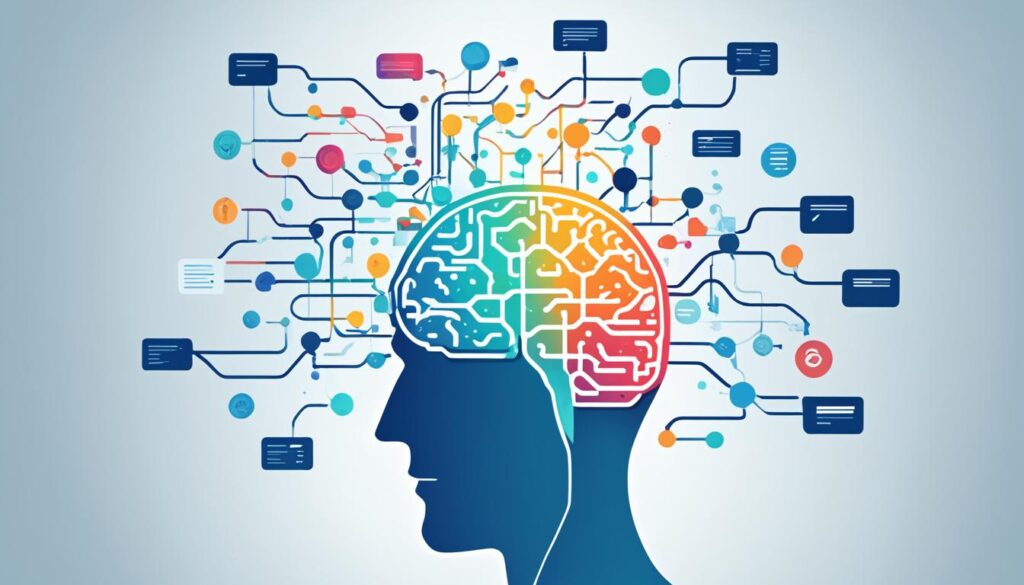“The world is changing very fast. Big will not beat small anymore. It will be the fast beating the slow.” – Rupert Murdoch
A key fact shows why being quick is vital in business: 77% of marketing ROI is from segmented, targeted campaigns. For small and medium-sized enterprises (SMEs), using AI-Driven Customer Segmentation opens up new ways to understand customer data and behavior. This allows for more personalized and strong marketing campaigns.
By using advanced AI tools, businesses can greatly improve how they group customers. This ensures their marketing is based on solid data and reaches the right people. SMEs find automated segmentation useful for quick analysis. It also removes old or useless data, making their marketing extremely accurate.
Key Takeaways
- AI-Driven Customer Segmentation offers enhanced accuracy and scalability, crucial for SMEs.
- Real-time customer insights provided by AI and ML allow businesses to tailor marketing campaigns effectively.
- Supervised and unsupervised ML categories offer different benefits for customer segmentation, making it versatile.
- AI technology helps identify complex customer patterns that traditional methods often miss.
- Improved segmentation leads to highly focused and personalized marketing experiences, increasing ROI.
Understanding AI-Driven Customer Segmentation
AI-driven customer segmentation uses advanced AI algorithms to analyze customer data and pinpoint distinct target groups more effectively. AI technology transforms customer segmentation, enabling companies to refine their marketing messages and strategies for various segments. This enhances personalization and adaptability in the market.
What is AI-Driven Customer Segmentation?
AI-Driven Customer Segmentation relies on artificial intelligence to efficiently gather, process, and understand vast amounts of customer data. Unlike traditional methods, it considers purchasing behavior, sentiment analysis from social media, and more. This method allows businesses to identify detailed customer segments, improving engagement and conversion rates.
How AI Technology Revolutionizes Customer Segmentation
AI technology revolutionizes customer segmentation in several ways. Businesses can access varied data sources, including CRM software, website analytics, and third-party providers, through data-driven segmentation. AI-powered customer groups benefit from real-time, dynamic segmentation. This allows for quick adjustments to marketing strategies based on customer behavior and preferences.
- Dynamic Segmentation: AI enables real-time adjustments to marketing strategies.
- Predictive Segmentation: Advanced algorithms forecast future customer behavior and preferences.
- Behavioral Modeling: Identifies patterns in customer behavior for personalized marketing.
The Role of Machine Learning in Segmentation
Machine learning is central to AI-driven segmentation. It continuously analyzes data, learns, and makes predictions. This process enhances the way customer segmentation evolves. Predictive segmentation and machine learning models identify patterns for more personalized marketing efforts.
AI segmentation creates customer personas by analyzing detailed customer data. This allows for more tailored marketing. Behavioral modeling specifically enables hyper-personalization. It delivers custom experiences to individual customers based on detailed data. This includes considering time, location, and past interactions to further personalize experiences.
| Segmentation Type | Description |
|---|---|
| Demographic | Based on age, gender, income, etc. |
| Geographic | Based on location, region, climate, etc. |
| Psychographic | Based on lifestyle, values, interests, etc. |
| Behavioral | Based on purchasing behavior, usage, etc. |
In conclusion, AI-driven customer segmentation offers significant advantages. This method advances beyond traditional segmentation, providing deep insights. These insights help businesses build strong customer relationships and achieve marketing success through personalized, machine learning-driven strategies.
Benefits of AI in Customer Segmentation for SMEs
Small and medium-sized enterprises (SMEs) can hugely benefit from using AI for customer segmentation. AI technology helps businesses market more effectively and get a better return on investment. We’ll talk about the main perks of using AI for segmentation in SMEs.
Improving Data Accuracy
One big plus of segmentation software AI is making data more accurate. AI algorithms clear up and refine data, getting rid of duplicates and old information. This gives a clean and updated look at customer data. It makes targeting and personalizing messages much easier. Businesses using AI for this have seen big improvements in how accurate their data is.
Enhancing Personalization Efforts
AI is key in boosting personalization efforts. Predictive analytics segmentation lets SMEs make marketing campaigns that really fit customer needs and likes. Data shows that businesses with tailored marketing strategies can see conversion rates up to 1.5% higher. This strong personalization helps keep customers happy and loyal. Small businesses have seen customer retention go up by as much as 50%.
Optimizing Resource Allocation
Using resources well is crucial for getting the most from marketing investments. Advanced segmentation technology helps businesses spot the customer segments that bring in most of their revenue. AI-driven predictive analytics segmentation helps SMEs focus on the most promising segments. This means they can spend their marketing dollars more wisely. Plus, AI tools can cut the cost of finding new customers by 15-20%, making marketing even more effective.
| Benefit | Impact |
|---|---|
| Increase in Marketing ROI | 5-25% |
| Conversion Rate Improvement | Up to 1.5% |
| Customer Retention Increase | Up to 50% |
| Customer Satisfaction & Loyalty | 20-30% |
| Revenue Contribution by High-Value Customers | Over 70% |
| Reduction in Customer Acquisition Costs | 15-20% |
| Improvement in Customer Engagement | 90% of SMEs |
| Increase in Sales Revenue | 10-15% |
In summary, bringing AI into customer segmentation offers many benefits for SMEs. It improves data accuracy, boosts personalization, and optimizes how resources are used. These AI-driven strategies lead to big improvements in marketing results and customer happiness.
Challenges and Limitations of AI in Customer Segmentation
AI has many benefits, but using it for customer segmentation has challenges. Despite 52% of companies spending over five percent of their digital budget on AI, having good quality data is key. One big issue for small and medium enterprises (SMEs) is keeping AI data quality high. Bad data quality can make AI less effective, causing mistakes in customer grouping.

It’s also critical to focus on ethical AI segmentation to avoid bias. AI must work fairly. This means we need to keep checking and improving its processes. With 63% of companies planning to spend more on AI, making sure it’s used ethically is more important than ever.
Protecting customer privacy is another big challenge with AI in customer segmentation. AI collects a lot of personal data, so keeping this information safe is essential. Companies need to follow laws and protect their data well, showing they care about their customers’ privacy.
Another issue is that businesses often lack skilled workers for AI. Setting up AI can take a long time. Having the right team is crucial for success. AI tools can sort out customer issues faster, making customers happier. But, we must regularly check these tools for biases to keep them working well.
To fully benefit from AI in customer segmentation, companies must address these issues. Spending on technology is necessary, but so is keeping AI ethical and data high-quality. Doing these things helps follow privacy laws, gains customer trust, and improves AI projects.
| Challenges | Impact | Solution |
|---|---|---|
| AI Data Quality | Inaccurate Segmentation | Continuous Data Quality Checks |
| Ethical AI Segmentation | Algorithmic Bias | Regular Algorithm Audits |
| Data Privacy | Legal and Compliance Risks | Secure Data Storage and Compliance |
| Skilled Personnel | Inefficient AI Deployment | Invest in Upskilling and Training |
Leveraging Predictive Analytics for Better Segments
Predictive analytics lets small and medium enterprises (SMEs) use AI for targeted marketing. It processes vast datasets better than humans. This leads to creating customer profiles using buying habits, online activity, browsing history, and feelings.

With advanced technology, firms can change their marketing fast for better customization. This increases customer involvement, loyalty, and sales. Different data types help in making detailed, informed groups.
AI-driven customer groups consider many factors, offering deeper insights. Companies can now give ultra-personalized experiences that boost engagement and loyalty.
Predictive segmentation uses smart algorithms to guess future customer actions and likes. It helps create special marketing efforts. Companies can quickly adjust, keeping up with trends and client needs.
AI combines info from interactions, buying history, and site visits. It uses methods like decision trees and neural networks for smart predictions. Automatic tasks free up time for focusing on important strategy choices.
The outlook for predictive analytics segmentation is bright with new tech like Transformers. There’s a focus on understandable AI, protecting privacy, and Edge AI. They’re raising the bar for data-driven grouping.
| Feature | Advantages |
|---|---|
| Data Integration | Combines data from multiple sources for comprehensive analysis |
| Machine Learning Models | Employs advanced algorithms for accurate prediction |
| Automated Segmentation | Saves time and focuses on strategic tasks |
| Future Adaptability | Prioritizes models like Transformers and techniques for privacy |
Combining AI with CRM Systems
Putting AI together with Customer Relationship Management (CRM) systems helps small to medium enterprises (SMEs) streamline their work. They can also improve how they interact with customers. This mix is crucial in the competitive world of business today.

Streamlining Data Entry and Management
Using AI with CRM makes data work much faster. AI tools can do routine tasks by themselves. This includes entering data, cleaning it, and making sure it’s correct and unique. Businesses can then focus more on big-picture projects.
Enhancing Customer Interaction Records
Machine learning segmentation in CRM systems improved by AI digs deep into customer talks. These systems look through a lot of data quickly. They use artificial intelligence segmentation to spot patterns. This helps understand what customers like and do. These insights help make interactions more personal. They target customer needs better, lifting their happiness.
Some CRM providers already have AI in their systems:
| Provider | AI Features |
|---|---|
| Salesforce’s Einstein GPT | Insights, predictions, and recommendations across business aspects |
| HubSpot’s ChatSpot | Automation of tasks like writing emails and creating reports |
| Zoho’s Zia | Conversational sales assistant providing CRM data and workflow suggestions |
| Freshworks’ Freddy AI | Chatbot automation for personalized customer service |
| Nutshell’s Power AI | Features like timeline summarization and Zoom transcription |
| Pipedrive’s Sales Assistant | Recommendations based on CRM data for optimizing sales processes |
CRM systems boosted by AI change how companies deal with customer info and talks. They make things work smoother. They also ensure interactions are more tailored and driven by insight.
Real-Time and Dynamic Campaign Optimization
Using AI, we dynamically optimize marketing campaigns as they happen. AI segmentation quickly and accurately processes huge amounts of customer data. This gives us insights that old methods can’t. Because of this, we can make very detailed customer profiles. This helps us target better and personalize our marketing.
We rely on things like CRM software, website analytics, and social media for AI-powered customer segmentation. These tools help us understand and react to how customers behave. This makes sure our marketing stays fresh and impactful as what customers want changes.
Dynamic AI also lets us change our strategies based on new customer data. This means we can keep giving personalized experiences. These experiences boost customer involvement and loyalty. Predictive segmentation helps us guess future customer actions, making our marketing more precise and focused.
When we use AI segmentation data, following rules like GDPR and CCPA is key to keep customer trust. Using this data ethically is as vital as the insights we get. Algorithms find patterns for highly personalized marketing. And, considering factors like time and place helps us target even better.
Dynamic segmentation shines in boosting Customer Lifetime Value (CLV) by delivering timely personalized marketing messages.
This new way of AI campaign optimization changes how we connect with our audience. It makes our marketing more effective and boosts ROI significantly. Understanding customer segments better helps businesses improve conversions and customer retention. Being able to change quickly gives us an edge in today’s fast market, pushing innovation and customer happiness.
- Processes large amounts of data quickly and accurately.
- Creates highly detailed customer profiles for precise targeting.
- Considers purchasing behavior, online interactions, and browsing history.
- Delivers personalized messages that increase engagement and loyalty.
- Allows for real-time adaptation based on evolving customer data.
AI tools offer more than just better efficiency. They lead to more advanced, data-driven marketing strategies that really connect with customers. The future of marketing is about perfectly blending dynamic AI segmentation with personalized AI, for continually evolving and improving campaigns.
| Benefits | Impact |
|---|---|
| Real-Time Campaign Optimization | Ensures marketing efforts remain relevant and impactful. |
| Accuracy in Data Processing | Enhances the creation of detailed customer profiles. |
| Dynamic Segmentation Capabilities | Enables real-time adaptation based on customer data. |
| Predictive Segmentation | Forecasts future customer behavior for more effective campaigns. |
| Hyper-Personalization | Delivers tailored messages and experiences at the individual level. |
Using AI Tools for Automated Customer Segmentation
AI tools are changing the game for small and medium enterprises (SMEs) looking for an edge. By using automated segmentation AI, these businesses can swiftly go through lots of customer data. This helps them divide customers more accurately.
AI-driven segmentation tools let SMEs save time and get more accurate data. These tools can spot common features in customers, like age or what they buy. This makes it easier to understand and reach different customer groups better.
AI tools offer many benefits for small businesses. They make analyzing customer segments faster and more accurate. Also, they predict what customers will want in the future, helping create personalized marketing campaigns. This personal touch improves relationships and customer experiences.
Using AI-driven segmentation tools also cleans up data by getting rid of duplicates or outdated info. Having accurate, clean data helps businesses understand their customers better. This lets them use their resources more wisely and improve their marketing.
Furthermore, AI helps businesses understand their customers more deeply and make marketing strategies that really fit them. This leads to customers staying longer and feeling happier with the brand.
In the end, using AI to automate marketing efforts helps SMEs stay flexible and keep up with market trends. These advanced tools help businesses improve how they divide up their market. This drives growth and keeps customers coming back.
AI-Powered Personalized Marketing Campaigns
AI-powered marketing is key for companies wanting to lead. It uses machine learning and data analytics to send tailored messages. These messages are aimed at specific groups, making them more effective. 49% of marketers feel they’re just guessing in their decisions. Meanwhile, all marketing leaders want to boost their AI tools.
Crafting and Testing Marketing Messages
AI tools analyze huge amounts of data, not just basic info. They look at what customers buy, their online activity, and feelings voiced on social media. This creates detailed customer pictures. With this info, companies can make messages that truly speak to customer likes. Google Ads shows how powerful AI segmentation can be in practice.
Identifying High Conversion Prospects
AI excels at spotting customers likely to make more purchases. It predicts customer actions, focusing on those with high potential value. This means firms can use their resources on the most promising groups. Despite higher initial costs, AI’s precise targeting boosts profits and customer involvement.
AI also respects privacy laws, like GDPR and CCPA, increasing customer loyalty. Pecan’s tools show how predictive AI can grow sales and engage customers more. This highlights the big wins from focusing on AI-driven strategies.



